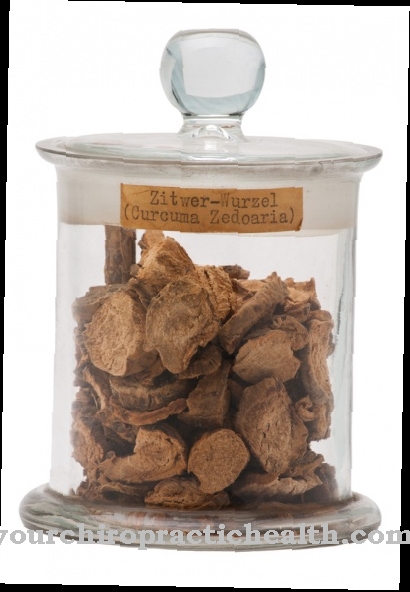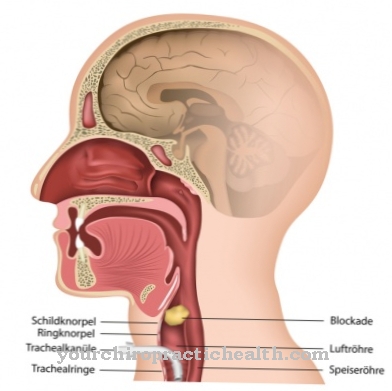Ceftazidime belongs to the active ingredient group of antibiotics. The remedy is part of the third generation cephalosporins.
What is Ceftazidime?

With ceftazidime, also called Ceftazidinum called, it is an antibiotic. It comes from the third generation of the cephalosporins, which in turn belong to the beta-lactam antibiotics, and is used to treat acute and chronic infections.
The antibiotic prevents the bacteria from building up an intact cell wall and ensures that the wall becomes permeable. In this way, the drug stimulates the death of harmful bacteria.
Pharmacological effect
The basis of the effect of ceftazidime is the disruption of the cell wall synthesis of the bacteria. As a result, the germs are no longer able to build an intact cell wall. This in turn causes the cell wall to be permeable and, in the further course of the process, causes the disease-causing bacteria to die.
During this process, ceftazidime adheres to special proteins inside the cells. Penicillins can also bind to these. Similar to the cephalosporin cefotaxime, ceftazidime acts on a broad front against gram-negative bacteria. In addition, the antibiotic is considered effective against the pathogens Pseudomonas aeruginosa and Burkholderia pseudomallei. The latter is responsible for the tropical disease melioidosis (pseudo-snot). In contrast to cefotaxime, however, ceftazidime has a weaker effect against gram-positive bacteria. Its positive effects on streptococci and staphylococci are limited.
Ceftazidime works in powder form. This is given to the patient by injection or infusion. The bioavailability of ceftazidime is around 91 percent. Ten percent of the antibiotic binds to plasma proteins in the blood. The plasma half-life averages 90 percent. 90 to 96 percent of ceftazidim is eliminated from the human body via the kidneys.
Medical application & use
Ceftazidime can be used to treat a wide variety of bacterial infections. Most notably, this includes pneumonia that occurs in a hospital. Bacterial meningitis, cystic fibrosis, chronic otitis media associated with the formation of pus, infections of bones and joints, complicated urinary tract infections, malignant inflammations of the outer ear and severe infections of the skin, muscles and tendons are also possible indications .
Ceftazidime is also suitable for the treatment of blood poisoning (sepsis), peritonitis (inflammation of the peritoneum) after a blood wash, complicated abdominal infections and fever due to a lack of neutrophils. Ceftazidime can also be useful as a preventive measure against urinary tract infection by surgically removing the male prostate (prostate gland) via the urethra.
In addition to adult patients and children, babies can also be treated with ceftazidime. Since ceftazidime is only suitable for treating certain pathogens, some types of infection cannot be treated with the antibiotic. The use of cephalosporin is only considered to be justified if the pathogen is classified with a high degree of probability as being sensitive to the agent.
Risks & side effects
As with other antibiotics, there is a risk of side effects from using ceftazidime.However, these do not occur in every patient. For example, allergies with these cephalosporins are significantly less common than after taking penicillin. Cross allergies to penicillins are also rarely recorded.
Ceftazidime is generally considered to be well tolerated. However, some people may experience inflammation or blockage of the blood vessels when given by vein, and inflammation and pain when given an injection of ceftazidime into a muscle.
Furthermore, an excess of blood platelets and immature blood cells, hives-like rash, a deficiency of neutrophil blood cells, nausea, vomiting, diarrhea, abdominal pain, headache, dizziness, itching, fever and a lack of blood platelets are possible. In rare cases there is a risk of kidney inflammation or even acute kidney failure.
Ceftazidime should not be administered if the patient is hypersensitive to the active substance or to other cephalosporins. The same applies to a previous allergic shock to penicillin, carbapenem or monobactam.
There is limited information on the effects of ceftazidime in pregnancy. Animal experiments did not reveal any harmful effects. However, ceftazidime is only prescribed to expectant mothers if there is no other option. The preparation can be administered during breastfeeding as there are no negative effects on the baby to be feared.
When administering ceftazidime, due to harmful interactions, it must be ensured that it is not mixed with alkaline solutions with a pH value above 7.5. In addition, mixing ceftazidime and aminoglycoside antibiotics should be avoided. There is a risk of negative impairment of kidney function from taking these two drugs.






















.jpg)





